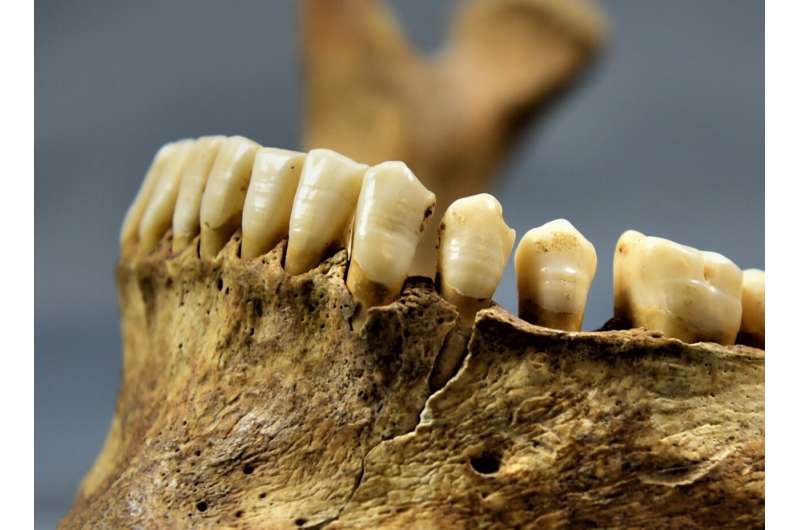This article has been reviewed according to Science X's editorial process and policies. Editors have highlighted the following attributes while ensuring the content's credibility:
fact-checked
peer-reviewed publication
trusted source
proofread
Childhood in medieval Bavaria: What teeth reveal about nutrition and migration

New research findings reveal that some children in early medieval Bavaria were breastfed for much longer periods than today. Also, many early Bavarians buried around 500 AD originate from other geographical regions where feeding practices apparently differed.
A team of researchers led by the SNSB anthropologists Michaela Harbeck and Maren Velte analyzed human teeth from various archaeological sites in Bavaria. Their research findings were published in PLOS ONE and Archaeological and Anthropological Sciences.
A team of researchers led by anthropologist PD Dr. Michaela Harbeck, curator at the Bavarian State Collection for Anthropology in Munich, Germany (SNSB-SAM) and the LMU doctoral student and project collaborator at the State Collection, Maren Velte, were able to obtain information about the earliest phase of life of adult humans from the early Middle Ages through isotope analyses of their teeth.
Harbeck and her colleagues analyzed human teeth from various medieval Bavarian cemeteries, mainly from the period around 500 AD. Teeth are formed during childhood and are characterized by little or no remodeling during lifetime. This developmental quality makes them an ideal "archive of childhood."
Strontium isotopes provide an indication of a person's geographical origin, while analyses of carbon and nitrogen provide information on diet. Serial isotope analysis shows the course of nutrition from birth to around 20 years of age. This method reveals the transition process from breast milk feeding in infancy to the inclusion of solid food during early childhood.
Complex migration processes
The origins of modern-day Europe date back to a period known as the Migration Period. During this time, which dates between Late Antiquity and the Middle Ages, the Western Roman Empire came to an end and profound cultural and political changes began.
Many towns, villages and settlements have their origins during this period. In southern Bavaria, the Bavarian duchy emerged from the former Roman province of Raetia secunda in the sixth century. The role migration played in this process remains a point of discourse. Stable strontium isotopes from over 150 early medieval human skeletal remains reveal that at the end of the 5th century, an above-average number of people of non-Bavarian origin migrated to the region of present-day southern Bavaria. These treks involved men as well as women.
"Although we cannot narrow down the exact areas of origin for many individuals, we can show that they came from various non-local regions," says Harbeck, lead author of the study.
Certain dietary patterns atypical for Bavaria further suggest a foreign origin of some of the buried individuals. Several women who were shown to have genetic markers characteristic for south-eastern Europe and who also exhibit artificially modified skulls, consumed a diet comprised mainly of millet during their formative years. Millet farming is common in Eastern Europe and even Asia, yet seldom grown in Bavaria at this time.
Harbeck states, "These women obviously grew up in other cultures outside of Bavaria. For some women, we were even able to narrow down the approximate time of their diet change and thus when they immigrated to Bavaria. Many of the women from south-eastern Europe, for example, did not immigrate as teenagers—as one might expect in the context of marriage migration at that time—but were already well over 20 years of age when they arrived in Bavaria."
Weaning and complementary food
A detailed dietary reconstruction from birth to around the age of 10, including the switch from breast milk to solid food, was conducted for some individuals. These analyses show that women in late antiquity and the early Middle Ages breastfed their children much longer than today.
As Maren Velte says in her doctoral thesis, "The weaning from breast milk was completed between the second and third year of life for most of the early Bavarians studied. Women of foreign origin in particular were obviously breastfed longer. Such long breastfeeding periods are known from nomadic peoples, for example."
'Weaning stress'
The weaning process always poses a certain health risk to an infant. Children are suddenly and repeatedly exposed to new pathogens, and potentially, malnutrition. Resulting visible malformations in tooth enamel that occur during dental development and are considered identifiable physiological stress markers, can be interpreted to determine at what age children were exposed to these stress events.
Infants raised in the period after the social upheavals in Bavaria apparently experienced a particularly high level of "weaning stress." In the 7th century, stress-related developmental changes in dental morphology are particularly frequent.
The research team believes that fundamental changes in childhood nutrition, especially with regard to complementary foods, are to blame. Future research will reveal more details.
More information: Maren Velte et al, Between Raetia Secunda and the dutchy of Bavaria: Exploring patterns of human movement and diet, PLOS ONE (2023). DOI: 10.1371/journal.pone.0283243
Maren Velte et al, Tracing early life histories from Roman times to the Medieval era: weaning practices and physiological stress, Archaeological and Anthropological Sciences (2023). DOI: 10.1007/s12520-023-01882-6
Journal information: PLoS ONE
Provided by The Bavarian Natural History Collections


















